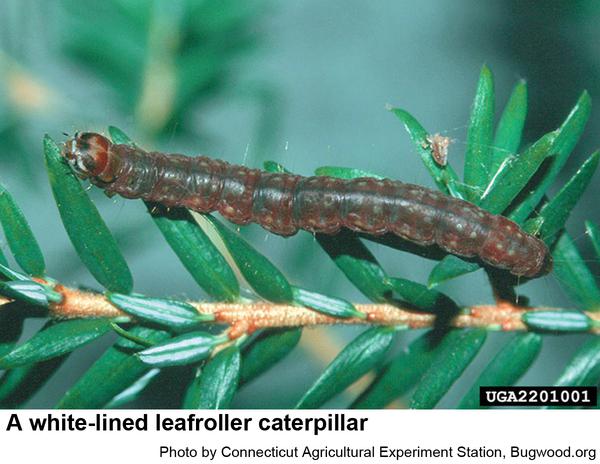Description and Biology
The moth of the white-lined leafroller, Amorbia humerosana, is a small, mottled tan to brown or gray insect speckled with tiny black spots. The antennae are slender. The moths are 1/2 to 5/8 inch long when at rest. Whitelined leafrollers are yellowish green to brown with an orange brown head and grow to 1 or even 11/4 inch long. They can be distinguished by a dark brown to black band on the head and side of the prothorax with a distinct white line above (identification of small, young caterpillars is difficult as the lateral bands are often absent). The skin is covered in microscopic, sharp spinules. These caterpillars are slender, with three pairs of thoracic legs and five pairs of fleshy, abdominal legs. The abdominal legs have tiny crochets (hooks) that form an almost perfect but incomplete circle. On broadleaf hosts, they roll leaves to form a shelter from which they venture out to feed. Mature whitelined leafrollers crawl or drop to the soil and pupate, sheltered by debris. New moths emerge as early as March and fly throughout the growing season. The winter is spent in debris on ground. Mature caterpillars present from July to September. We have one generation per year.
Host Plants
The white-lined leafroller has a surprisingly large number of host plants including conifer such as fir, larch, pine, and spruce. Other broadleaf plants include alder, apple, birch, elm, holly, huckleberry, poison ivy, poplar, sumac, and other trees and shrubs.
Residential Recommendations
Because of its enormous host plant range, white-lined leafrollers are not likely to be resistant to pesticides. Should they become abundant enough to require suppression, consider using a pyrethroid because pyrethroids are very toxic to caterpillars but are not too hazardous to humans and pets (other than fish - avoid using pyrethoids around pools, ponds, and streams). Pyrethroids labeled for residential landscape use are readily available in most big box stores, plant centers, and nurseries. The active ingredient of pyrethroids ends with "-thrin." The active ingredient of all pesticides are listed on the front label usually in very small font near the bottom. Most pyrethroids have a long residual life in the environment.
Other Resources
- Arthropods of Florida and Neighboring Land Areas, Vol. 1 - Lepidoptera of Florida. Kimball, C.P. 1965. Div. Plant Ind. Fla. Dept. Agr.
- LepIntercept, An identification resource for intercepted Lepidoptera larvae. Todd M. Gilligan, T. M. and S. C. Passoa. 2014. Identification Technology Program (ITP), Fort Collins, CO.
- Phylogenetic relationships, systematics, and biology of the species of Amorbia Clemens (Lepidoptera: Tortricidae: Sparganothini). Rodríguez, E. P. and J. Powell. 2007. Zootaxa. 1-109.
- Species Amorbia humerosana - White-lined Leafroller - Hodges#3748. McLeod, R. et al. 2019 (update). Bugguide, Iowa State University Dept. Entomology.
- Taxonomy Browser: Amorbia humerosana. Anonymous. 2020 (copyright). Bold Systems.
- White-lined Leafroller (Amorbia humerosana). Maier, C.T. et al. 2004. BugwoodWiki.
- NC State Extension Plant Pathology Publications
- NC State Horticultural Science Publications
- North Carolina Agricultural Chemicals Manual
For assistance with a specific problem, contact your local Cooperative Extension center.
This factsheet has not been peer reviewed.
Publication date: July 11, 2020
Revised: July 20, 2020
Recommendations for the use of agricultural chemicals are included in this publication as a convenience to the reader. The use of brand names and any mention or listing of commercial products or services in this publication does not imply endorsement by NC State University or N.C. A&T State University nor discrimination against similar products or services not mentioned. Individuals who use agricultural chemicals are responsible for ensuring that the intended use complies with current regulations and conforms to the product label. Be sure to obtain current information about usage regulations and examine a current product label before applying any chemical. For assistance, contact your local N.C. Cooperative Extension county center.
N.C. Cooperative Extension prohibits discrimination and harassment regardless of age, color, disability, family and marital status, gender identity, national origin, political beliefs, race, religion, sex (including pregnancy), sexual orientation and veteran status.


